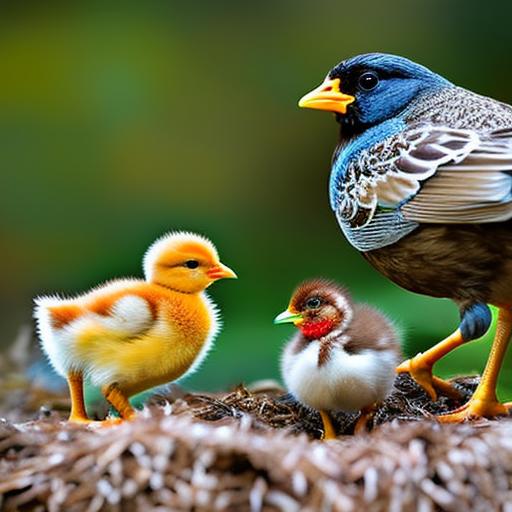Adding baby chicks to an established flock is an exciting time for any chicken owner. The sight of fluffy little chicks running around with their older counterparts is a heartwarming experience. However, it is important to introduce them properly to ensure a safe and happy environment for all chickens involved. This article will discuss the benefits and risks of keeping baby chicks with older chickens, how to ensure a safe and happy environment, tips for managing the pecking order, understanding the social dynamics of chickens, providing adequate space and resources, feeding and nutrition, health concerns, monitoring behavior and addressing issues, and the joy of watching baby chicks grow up with older chickens.
Key Takeaways
- Introducing baby chicks to older chickens requires careful planning and management.
- Keeping baby chicks with older chickens can provide benefits such as socialization and learning from experienced birds, but also carries risks such as injury and disease transmission.
- Creating a safe and happy environment for both baby chicks and older chickens involves providing adequate space, resources, and nutrition.
- Managing the pecking order is important when introducing baby chicks to an established flock, and can be done through gradual introductions and providing multiple food and water sources.
- Understanding the social dynamics of chickens is crucial for successfully keeping baby chicks with older chickens, and monitoring behavior and addressing issues is necessary for a healthy flock.
The Benefits and Risks of Keeping Baby Chicks with Older Chickens
Keeping baby chicks with older chickens has several benefits. One of the main advantages is socialization. Baby chicks learn from their older counterparts and develop important social skills. They observe how the older chickens interact with each other, establish a pecking order, and navigate their environment. This helps the baby chicks integrate into the flock more easily and become well-adjusted members.
Another benefit is that older chickens can provide warmth and protection to the baby chicks. The older hens often take on a motherly role and help keep the chicks warm by huddling together. They also protect them from predators and teach them important survival skills.
However, there are also risks involved in keeping baby chicks with older chickens. One risk is injury. Older chickens may accidentally injure the fragile baby chicks while moving around or during aggressive interactions. It is important to closely monitor their interactions to prevent any harm.
Another risk is disease transmission. Baby chicks are more susceptible to diseases than older chickens due to their underdeveloped immune systems. Older chickens may carry diseases without showing symptoms, which can be transmitted to the baby chicks. It is crucial to practice good biosecurity measures to minimize the risk of disease transmission.
How to Ensure a Safe and Happy Environment for Baby Chicks and Older Chickens
To ensure a safe and happy environment for both baby chicks and older chickens, it is important to provide adequate space, shelter, and resources. Each chicken should have enough space to move around comfortably without feeling crowded. This helps prevent aggression and bullying.
Adequate shelter is also essential. Baby chicks need a warm and secure area where they can be protected from the elements and predators. A brooder box with a heat source is ideal for the first few weeks of their lives. Older chickens should have access to a coop that provides protection from predators and adverse weather conditions.
Providing enough resources such as food, water, and nesting areas is crucial. Separate feeding and watering stations should be set up to prevent bullying and ensure that all chickens have access to food and water. Sufficient nesting areas should be provided for the older hens to lay their eggs without disturbance.
Monitoring behavior is also important to ensure a safe environment. Any signs of aggression or bullying should be addressed immediately to prevent injury or stress. Separating birds if necessary or providing distractions such as toys or treats can help redirect their behavior.
Managing the Pecking Order: Tips for Introducing Baby Chicks to an Established Flock
Establishing a pecking order is a natural process in chicken flocks, and it is important to manage it safely when introducing baby chicks to an established flock. The pecking order determines the social hierarchy within the flock, with dominant birds having priority access to resources.
When introducing baby chicks, it is best to do so gradually. Start by placing the baby chicks in a separate area within the coop or run where they can see and hear the older chickens but are protected from direct contact. This allows them to become familiar with each other’s presence without the risk of injury.
After a few days, you can start supervised introductions. Place the baby chicks in a wire cage or pen within the coop or run, allowing the older chickens to approach and interact with them. This allows the older chickens to establish their dominance without causing harm to the baby chicks.
Supervision is crucial during the introduction process to ensure the safety of all chickens. If any aggression or bullying occurs, separate the birds and try again at a later time. It may take several attempts before they can coexist peacefully.
Understanding the Social Dynamics of Chickens: What to Expect When Keeping Baby Chicks with Older Chickens
Understanding the social dynamics of chickens is important when keeping baby chicks with older chickens. Chickens have a hierarchical social structure, with dominant birds at the top and submissive birds at the bottom. The addition of baby chicks can disrupt this hierarchy and cause temporary changes in behavior.
When baby chicks are introduced, the older chickens may initially show curiosity or indifference. However, as the baby chicks grow and become more independent, the older chickens may display aggression or territorial behavior. This is their way of establishing dominance and maintaining their position in the pecking order.
It is important to be patient and observe their interactions closely during this time. Some squabbles and pecking are normal as they establish their hierarchy. However, if any chicken shows signs of distress or injury, it is important to intervene and separate them.
Providing Adequate Space and Resources for Baby Chicks and Older Chickens

Providing adequate space and resources is crucial for both baby chicks and older chickens. Baby chicks have specific needs that should be met to ensure their health and well-being. They require a heat source, such as a heat lamp or brooder plate, to maintain their body temperature during the first few weeks of life. The brooder box should be large enough to accommodate their growth and provide enough space for them to move around comfortably.
Baby chicks also require appropriate feed that is specifically formulated for their nutritional needs. A starter feed with a high protein content is recommended for the first few weeks, gradually transitioning to a grower feed as they mature. It is important to provide fresh water at all times, ensuring that it is easily accessible and at an appropriate height for the baby chicks.
Older chickens should also have access to adequate space and resources. They require a coop that is spacious enough for them to move around comfortably and roosting bars for resting. Nesting boxes should be provided for the hens to lay their eggs, with enough space to accommodate all the hens without overcrowding.
Separate feeding and watering stations should be set up to prevent bullying and ensure that all chickens have access to food and water. This helps minimize stress and aggression within the flock.
Feeding and Nutrition: Meeting the Unique Needs of Baby Chicks and Older Chickens
Feeding and nutrition play a crucial role in the health and development of both baby chicks and older chickens. Baby chicks have different nutritional needs compared to older chickens due to their rapid growth and development.
For baby chicks, a starter feed with a high protein content is essential for their growth. The starter feed should contain around 18-20% protein to support their muscle and feather development. It should also contain essential vitamins and minerals for their overall health.
As the baby chicks grow, they can transition to a grower feed with a slightly lower protein content. The grower feed should contain around 16-18% protein to support their continued growth and development.
Older chickens have different nutritional needs compared to baby chicks. They require a balanced diet that includes a combination of grains, protein, vitamins, and minerals. A layer feed with around 16-18% protein is recommended for laying hens to support egg production.
It is important to provide fresh water at all times for both baby chicks and older chickens. Water should be easily accessible and kept clean to prevent the spread of diseases.
Health Concerns: Protecting Baby Chicks from Disease and Injury in a Mixed-Age Flock
Protecting baby chicks from disease and injury is crucial when keeping them with older chickens in a mixed-age flock. Baby chicks are more susceptible to diseases due to their underdeveloped immune systems, and older chickens may carry diseases without showing symptoms.
Practicing good biosecurity measures is essential to prevent disease transmission. This includes regularly cleaning and disinfecting the coop and equipment, quarantining new birds before introducing them to the flock, and practicing good hygiene when handling chickens.
Monitoring for signs of illness or injury is also important. Any changes in behavior, appetite, or appearance should be investigated further. If any chicken shows signs of illness or injury, it should be isolated and treated accordingly to prevent the spread of disease.
Preventing injury is also important. Baby chicks are fragile and can easily be injured by the older chickens. Providing adequate space, supervision during introductions, and separate feeding and watering stations can help minimize the risk of injury.
Monitoring Behavior and Addressing Issues: How to Identify and Solve Problems in a Flock with Baby Chicks and Older Chickens
Monitoring behavior is crucial when keeping baby chicks with older chickens. It allows you to identify any issues that may arise and address them promptly. Common issues that may occur include bullying, aggression, or stress.
Bullying can occur when older chickens peck or chase the baby chicks excessively. This can cause stress and injury to the baby chicks. If bullying occurs, it is important to separate the birds temporarily until they can coexist peacefully.
Aggression can also occur when establishing the pecking order. This is normal behavior as long as it does not result in injury or distress. However, if any chicken shows signs of distress or injury, it is important to intervene and separate them.
Stress can occur in both baby chicks and older chickens. Signs of stress include decreased appetite, feather picking, excessive vocalization, or lethargy. If any chicken shows signs of stress, it is important to identify and address the underlying cause. This may involve providing more space, reducing overcrowding, or addressing any environmental factors that may be causing stress.
The Joy of Watching Baby Chicks Grow Up with Older Chickens: Tips for Enjoying the Experience and Building a Strong Flock
Watching baby chicks grow up with older chickens is a joyous experience for any chicken owner. It is a testament to the natural instincts and social dynamics of chickens. By providing proper care and attention, you can build a strong and healthy flock.
Enjoying the experience involves observing their interactions, learning from their behaviors, and appreciating their unique personalities. Each chicken has its own quirks and preferences, and getting to know them individually can be a rewarding experience.
Building a strong flock involves providing adequate space, shelter, and resources for all chickens. It also involves practicing good biosecurity measures to prevent disease transmission and monitoring behavior to address any issues that may arise.
By being mindful of their unique needs and behaviors, you can create a safe and happy environment for both baby chicks and older chickens. This allows them to thrive and grow together, creating a strong bond within the flock.
Adding baby chicks to an established flock is an exciting time for any chicken owner. However, it is important to introduce them properly to ensure a safe and happy environment for all chickens involved. By understanding the benefits and risks of keeping baby chicks with older chickens, providing adequate space and resources, managing the pecking order safely, understanding the social dynamics of chickens, meeting their nutritional needs, protecting them from disease and injury, monitoring behavior, and addressing issues promptly, you can enjoy the experience of watching baby chicks grow up with older chickens while building a strong and healthy flock.
If you’re wondering whether you can keep baby chicks with older chickens, you’ll find some helpful insights in this article from Poultry Wizard. They provide valuable information on how to successfully integrate different age groups of chickens in your coop. Understanding the dynamics and taking necessary precautions is crucial for the well-being of your flock. To learn more about this topic and other useful poultry-related articles, visit Poultry Wizard’s website at https://poultrywizard.com. Additionally, if you’re interested in turning a shed into a chicken coop or exploring the possibility of keeping guinea fowl with chickens, Poultry Wizard has dedicated articles on these subjects as well. Check out their articles on turning a shed into a chicken coop and keeping guinea fowl with chickens for more insights.
FAQs
What is the recommended age to introduce baby chicks to older chickens?
It is recommended to introduce baby chicks to older chickens when they are at least 6-8 weeks old and have grown feathers.
What is the best way to introduce baby chicks to older chickens?
The best way to introduce baby chicks to older chickens is to gradually introduce them to each other in a neutral territory and monitor their interactions closely.
Can baby chicks be kept with roosters?
Yes, baby chicks can be kept with roosters as long as they are introduced gradually and the rooster is not aggressive towards them.
What are the risks of keeping baby chicks with older chickens?
The risks of keeping baby chicks with older chickens include the older chickens pecking or injuring the baby chicks, transmitting diseases to the baby chicks, and the baby chicks not getting enough food or water.
What should be done if the older chickens are aggressive towards the baby chicks?
If the older chickens are aggressive towards the baby chicks, they should be separated immediately and reintroduced at a later time when they are more accepting of each other.
What should be done to ensure the safety and health of baby chicks when kept with older chickens?
To ensure the safety and health of baby chicks when kept with older chickens, they should be provided with a separate area for food and water, monitored closely for any signs of injury or illness, and given appropriate vaccinations and medications.
Meet Walter, the feathered-friend fanatic of Florida! Nestled in the sunshine state, Walter struts through life with his feathered companions, clucking his way to happiness. With a coop that’s fancier than a five-star hotel, he’s the Don Juan of the chicken world. When he’s not teaching his hens to do the cha-cha, you’ll find him in a heated debate with his prized rooster, Sir Clucks-a-Lot. Walter’s poultry passion is no yolk; he’s the sunny-side-up guy you never knew you needed in your flock of friends!







